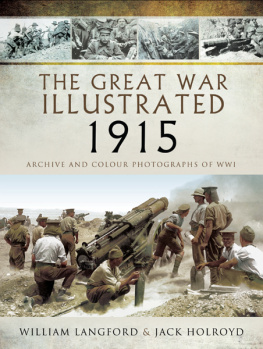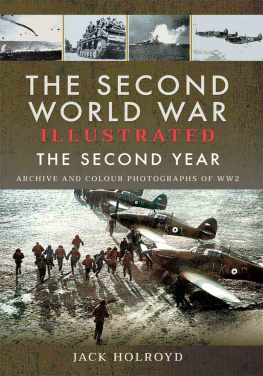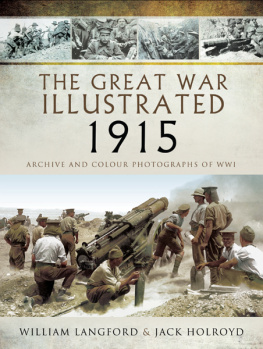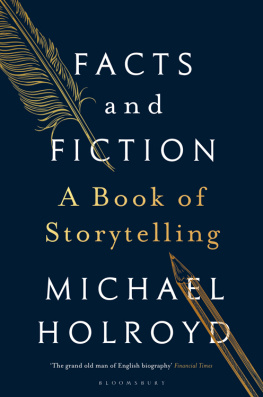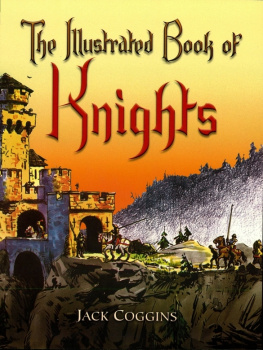Holroyd Jack - The Second World War Illustrated
Here you can read online Holroyd Jack - The Second World War Illustrated full text of the book (entire story) in english for free. Download pdf and epub, get meaning, cover and reviews about this ebook. year: 2019, publisher: Pen & Sword Books, genre: History. Description of the work, (preface) as well as reviews are available. Best literature library LitArk.com created for fans of good reading and offers a wide selection of genres:
Romance novel
Science fiction
Adventure
Detective
Science
History
Home and family
Prose
Art
Politics
Computer
Non-fiction
Religion
Business
Children
Humor
Choose a favorite category and find really read worthwhile books. Enjoy immersion in the world of imagination, feel the emotions of the characters or learn something new for yourself, make an fascinating discovery.
- Book:The Second World War Illustrated
- Author:
- Publisher:Pen & Sword Books
- Genre:
- Year:2019
- Rating:5 / 5
- Favourites:Add to favourites
- Your mark:
- 100
- 1
- 2
- 3
- 4
- 5
The Second World War Illustrated: summary, description and annotation
We offer to read an annotation, description, summary or preface (depends on what the author of the book "The Second World War Illustrated" wrote himself). If you haven't found the necessary information about the book — write in the comments, we will try to find it.
The Second World War Illustrated — read online for free the complete book (whole text) full work
Below is the text of the book, divided by pages. System saving the place of the last page read, allows you to conveniently read the book "The Second World War Illustrated" online for free, without having to search again every time where you left off. Put a bookmark, and you can go to the page where you finished reading at any time.
Font size:
Interval:
Bookmark:

The Second World War Illustrated
The First Year
The First Year
J ACK H OLROYD

Dedicated to the One True Sovereign
To serve as a visual reminder of the consequences when
mankind persists in a course of rebellion against His rulership
First published in Great Britain in 2019 by
PEN & SWORD MILITARY
an imprint of
Pen & Sword Books Ltd,
47 Church Street, Barnsley,
South Yorkshire.
S70 2AS
Copyright Jack Holroyd 2019
ISBN 978 1 52674 440 1
eISBN 978 1 52674 441 8
Mobi ISBN 978 1 52674 442 5
The right of Jack Holroyd to be identified as Author of this Work
has been asserted by him in accordance with the
Copyright, Designs and Patents Act 1988.
A CIP catalogue record for this book is available from the British Library
All rights reserved. No part of this book may be reproduced or transmitted
in any form or by any means, electronic or mechanical including photocopying,
recording or by any information storage and retrieval system,
without permission from the Publisher in writing.
Pen & Sword Books Ltd incorporates the imprints of
Pen & Sword Books Limited incorporates the imprints of Atlas, Archaeology, Aviation,
Discovery, Family History, Fiction, History, Maritime, Military, Military Classics, Politics,
Select, Transport, True Crime, Air World, Frontline Publishing, Leo Cooper, Remember
When, Seaforth Publishing, The Praetorian Press, Wharncliffe Local History, Wharncliffe
Transport, Wharncliffe True Crime and White Owl.
For a complete list of Pen & Sword titles please contact:
PEN & SWORD BOOKSS LIMITED
47 Church Street, Barnsley, South Yorkshire, S70 2AS, England.
e-mail:
Website: www.pen-and-sword.co.uk
Or
PEN AND SWORD BOOKS
1950 Lawrence Rd, Havertown, PA 19083, USA
e-mail:
Website: www.penandswordbooks.com
by Nigel Cave
The Second World War Illustrated The First Year
It is very difficult to imagine the impact on peoples of the traumatic events of the first twelve months of the Second World War that followed its outbreak in September 1939. Today we can look at them from the safety of knowing that the Axis regimes were soundly and utterly defeated after a struggle lasting six years that impacted far more widely than its horrific predecessor of 1914-1918.
The Second World War or at least the timing of its outbreak came as a surprise. But the conditions for a major conflict had been brewing for some time. Economic depression, as is historically usually the case, lay at the root of the emergence of increasingly extreme governments, be it in Japan, in Italy or Germany, as well as in a number of less internationally significant states. In Italy and Germany in particular it took the form of a state that increasingly took control of more and more aspects of the economy and of peoples lives. The regimes in these countries offered stability and often economic reassurance, especially after the traumas of the Great Depression. They combined some or all the aspects of anti-capitalism, anti-trade unionism, anti-religion almost anything that offered an alternative power base. They played heavily on nationalism and the fear of internal groups (such as the Jews) or of other nations (such as the Russians) or of both. They sought to emphasise prestige. They certainly posed a threat to traditional western liberal democracy.
Thus by 1939 there was a fractured, disjointed international scene. The United States was isolationist and utterly focussed on rebuilding after the devastation of the depression years. The Soviet Union was ruled by the paranoid and ruthless Stalin, best illustrated by the virtual extermination of the senior officer class in the Red Army Purges of the late thirties. Hitler was determined to restore Germany to its rightful status whether by expanding its borders to a Greater Germany or by righting the perceived wrongs that were inflicted at Versailles. Central and eastern Europe comprised a jumble of generally small states created by the post-war treaties, riven with political instability and regarding each other with jealousy. France had gone through a turbulent political period, far greater than that suffered in Britain.
War, therefore, was not a surprise; but it was greeted with weary resignation by Britain and France when it came, with no clear idea of what the objectives of the conflict might be, in stark contrast to Nazi Germany. The western democracies prepared for all sorts of horrors, particularly the dangers from the air and from gas attack. But after a frenetic first couple of months of war, by the end of which nothing particularly awful had happened on the Home Front, at least, the front line became almost relaxed.
This situation came to a sudden and cataclysmic end in the spring of 1940. In a matter of a couple of months the map of Europe was transformed. Germany and Russia, if not exactly allies, were linked by a non-aggression pact that gave Hitler the ability to concentrate his forces on the West, something that had been denied his predecessors in 1914. Stalins signature on the pact was largely the consequence of the realisation that Russia was quite incapable of conducting a major war, in no small measure a situation that was of his own making.
In a series of devastating strikes over an extraordinarily short period of time, Hitler achieved total dominance in western Europe. He removed any opposition that might have been provided by Denmark, Norway, the Netherlands, Belgium and France, having already dismembered, absorbed or neutralised the states on his eastern frontiers. He had friendly regimes on his southern border in the shape of Mussolinis Italy and the benevolent neutrality of post-Civil War Spain in the Franco regime and the dictatorship of Salazars Portugal. He had achieved security on the continent, leaving only the vestiges of a quasi-independent France governed from the backwater town of Vichy. Some countries remained theoretically autonomous whilst being under the unquestionable dominance of the German military machine.
For the British there seemed to be a never ending tide of bad news, leaving it and its Empire and Dominions by the summer of 1940 more or less alone to face the dictators. There were set backs at sea, from the submarine menace; there were set backs in Africa (though some triumphs as well); control of the Mediterranean and the routes to India were under extreme threat; there was defeat in Norway after a half-hearted intervention there; and there was the disaster of the fall of France and the ignominious withdrawal of the BEF from the continent.
Finally, there was the very real threat of an assault on Britain itself. A substantial invasion force was poised to cross the Channel and there was very little that could have withstood such a force if it had ever made it to a secure beachhead on Britains shores. The battle over the skies was crucial. The detail of the Battle of Britain who shot down how many planes, for example is not really the point. At the end of several weeks of intensive aerial combat the Germans made the fateful decision to switch the focus of their attack from the capability of the RAF to Britains cities, notably (but far from exclusively) London. It was a fundamental error, though it may not have seemed like that to the civilians who endured the Blitz months.
This hardly made the situation any more comforting for Great Britain and its well-wishers. But what had emerged was a national, coalition government of conviction and of talent. It was able to portray an image of a united, resolute and dogged nation, despite military disaster and the destruction of towns, homes and a calculated attack on civilians. However, this did not make for a military threat that was anything much more than a nuisance to Adolf Hitler. Never particularly keen on a war with Britain (other than to reduce her to a second rate and, effectively, subservient power), Hitler determined on pursuing his aims in the east, extending deep into the territory of Soviet Russia and incorporating great chunks of it into his Greater Germany, his German Reich. Only then would Germany have achieved its destiny.
Font size:
Interval:
Bookmark:
Similar books «The Second World War Illustrated»
Look at similar books to The Second World War Illustrated. We have selected literature similar in name and meaning in the hope of providing readers with more options to find new, interesting, not yet read works.
Discussion, reviews of the book The Second World War Illustrated and just readers' own opinions. Leave your comments, write what you think about the work, its meaning or the main characters. Specify what exactly you liked and what you didn't like, and why you think so.


